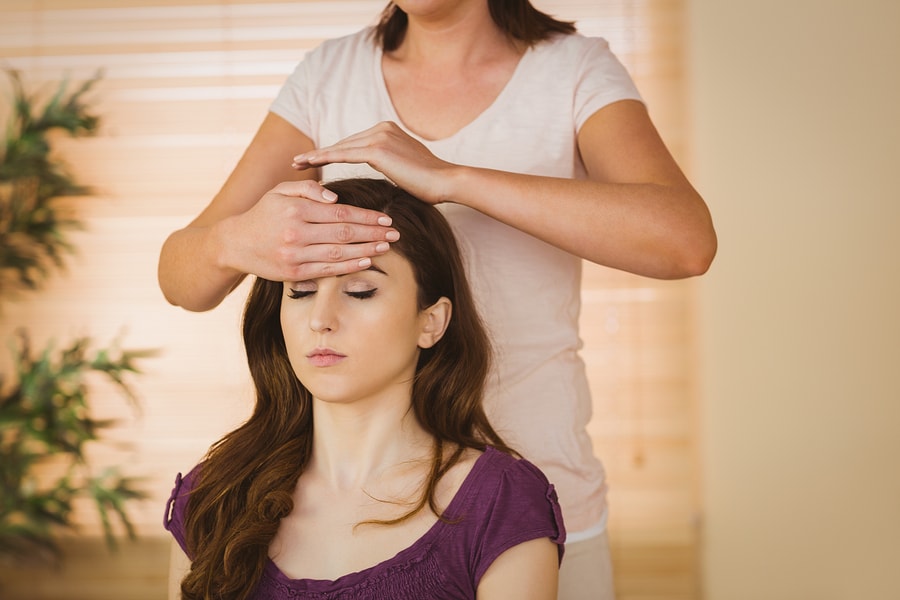
Reiki, similar to therapeutic touch and reflexology, is a relaxing form of “energy therapy” that is applied through gentle touch (or, no touch at all). Unlike many other forms of alternative medicine, its effects have been scientifically investigated—but does it have a mechanism beyond the placebo effect? Read on to learn more.
What Is Reiki?
Reiki is an ancient Japanese form of stress reduction and relaxation. It involves a light, slow progression of hand positions just above or on the clothed body [1, 2].
Each position during the session is held for approximately 5 minutes. Each session can be as short or as long as needed, although they generally last about 45 to 90 minutes [3, 2].
A Reiki practitioner typically recommends 3 sessions. However, the specific amount is different for each person [1].
According to The National Center for Complementary and Integrative Health (NCCIM), Reiki is based on an Eastern belief in an energy that supports the body’s innate or natural healing abilities. Reiki healers believe that they can transfer this healing energy from the universe, through the practitioner and to the patient [4].
Practitioner Claims
Traditionally, Reiki practitioners believe that this treatment deals with “subtle energy,” or a “biofield” [4, 5].
However, several experiments have demonstrated that under rigorous testing conditions, practitioners of “therapeutic touch” techniques (a term that includes Reiki, as well as other “alternative medicine” techniques) were unable to sense a “biofield” [6, 7].
Others have tried to explain Reiki’s supposed effects using quantum physics, though they have no precise hypothesis as to how it would work [8, 5].
There is no scientific way to measure or detect the “energy” that practitioners claim is central to Reiki, and so there is no evidence that Reiki actually works the way that its believers claim it does [4].
Other Possibilities
Alternatively, it could be argued that any health benefits of Reiki are just a placebo effect [1].
In fact, many studies that compare treatments with “real” and “sham” (fake) Reiki find similar effects between the two, further suggesting that the placebo effect might be responsible [9, 10].
Other studies, however, have reported Reiki has effects over and beyond various placebo conditions [1].
Nonetheless, a number of studies have found that Reiki may have benefits as a complementary treatment alongside conventional medicine [1, 11, 12].
Overall, if Reiki works primarily because of the placebo effect, it may be helpful to those who genuinely believe in it.
Potential Health Benefits
The FDA has not approved Reiki for any health condition or medical claim, largely because there is no conclusive evidence of Reiki working beyond the placebo effect. For the same reason, it is considered very safe, but it should never be used in place of something your doctor recommends or prescribes.
Insufficient Evidence For
The following purported benefits are only supported by limited, low-quality clinical studies. There is insufficient evidence to support the use of Reiki for any of the below listed uses.
1) Anxiety
Reiki has been studied for its ability to reduce anxiety in both healthy subjects and patients undergoing medical treatments.
While some studies claim that it can help, the evidence is mixed.
A recent meta-review of reiki’s potential as a complementary treatment in health and medicine concluded that Reiki is better than placebo in inducing a physically relaxed state [1].
A study evaluated the effects of Reiki as an alternative and complementary approach to treat pain, depression, and anxiety in 20 senior citizens. Participants in the experimental group experienced relaxation, improved physical symptoms, and enhanced mood [13].
In a 4-week case study, Reiki reduced stress, anxiety, and pain in 6 elderly patients with dementia [14].
However, another systematic review of 3 randomized controlled trials, which included 25 people with anxiety, concluded that there is insufficient evidence to consider Reiki beneficial for anxiety [7].
Reiki has also assisted as a complementary method in the treatment of other mental and physical problems. For example, in a pilot study, 21 subjects undergoing colonoscopy reported reduced heart rate, blood pressure, and breathing after Reiki therapy, indicating reduced anxiety [15].
The study also suggested that additional pain medication may not be needed for colonoscopy patients receiving reiki therapy [15].
However, in a different study, 50 out of 100 patients undergoing heart surgery received Reiki. Levels of IL-6 (a protein that causes an inflammatory response) in the Reiki and control groups were similar after the surgery. The study concluded that Reiki has no significant clinical benefit on mechanisms that are scientifically measured [16].
Similarly, a randomized pilot study that tested reiki in 32 women undergoing breast biopsy did not find evidence that Reiki reduces anxiety [17].
2) Depression
A pilot study divided 90 elderly patients equally into reiki, sham Reiki placebo, and control. The Reiki group had decreased depression levels on the 4th, 8th, and 12th weeks [1].
However, a systematic review of 3 RCTs that included 37 patients with anxiety or depression concluded that there is insufficient evidence to determine the usefulness of Reiki for depression [7].
3) Stress
In a 1-year study of 45 patients, reiki reduced the symptoms of depression and stress. Positive results remained even after a year of treatment [18].
A study conducted on rats found that Reiki reduced the negative effects of noise-induced stress [19].
4) Fatigue
A pilot study of 100 university student volunteers found that Reiki was more effective than placebo, music, or meditation for promoting physical relaxation, although there was no difference in mental relaxation [20].
In a pilot study of 16 cancer patients, participants in the Reiki group showed significant improvements in quality of life. They had less tiredness, pain, and anxiety scores compared to the rest-only (control) group. Furthermore, these beneficial effects remained for at least 1 week after 5 Reiki sessions [11].
A pilot study investigated the effects of Reiki in 21 healthcare professionals with “burnout” syndrome, a condition involving work-related mental and emotional exhaustion. A single session of reiki increased heart rate variability and body temperature but not salivary cortisol levels, indicating that reiki shifted their body functions to a more “relaxed” mode [21].
5) Quality of Life in Cancer Patients
Reiki’s effects have been studied in cancer patients, although it is unclear whether the conclusions of these are due to the placebo effect.
A study compared the effects of reiki vs. placebo (“sham” or fake Reiki) in 100 cancer patients. Quality of life in patients with cancer was significantly better in the group who received “real” reiki treatment, suggesting a genuine benefit [22].
However, a study in 189 chemotherapy patients found that participants in both the Reiki and sham Reiki placebo groups showed more comfort before and after chemotherapy, as well as better well-being outcomes, compared to the standard care group. The fact that both “real” and “fake” reiki had this effect may suggest that this benefit is simply due to a placebo effect [9].
6) Blood Pressure
A study investigated the effect of Reiki as a complementary technique to control high blood pressure in 66 patients with hypertension. Blood pressure in the Reiki group was reduced the most, followed by the placebo and control groups [23].
A pilot study (45 subjects) demonstrated that reiki reduced heart rate and diastolic blood pressure significantly after each session [24].
A randomized study of 49 patients determined that Reiki therapy provided within 72 hours after treatment of acute coronary syndrome improved heart rate variability as compared to rest and music [25].
However, a study of 20 senior patients with depression and anxiety found no changes in heart rate and blood pressure, although the participants in the Reiki group felt relaxed and had a general sense of well being [13].
Similarly, a study of 90 patients who underwent cesarean delivery reported that Reiki therapy did not reduce blood pressure or heart rate [12].
7) Pain
A pilot study conducted on 78 participants reported that Reiki was as effective as physical therapy in improving range of motion in patients with painful shoulder limitation [26].
A pilot study revealed that 16% of patients who received Reiki together with a sedative medication before colonoscopy needed less pain-killing medication during the procedure compared to the control group [27].
A study of 90 patients who underwent cesarean delivery reported that Reiki therapy reduced the intensity of pain, anxiety, and breathing rate, as well as the amount of painkillers they needed [12].
A pilot study in 22 women who underwent hysterectomy (removal of the uterus) reported that the Reiki group experienced less pain and requested fewer painkillers than the control group after surgery [28].
Reiki improved quality of life in 12 adult cancer patients, although it did not reduce their need for (opioid) painkillers. However, the Reiki treatment in this study was administered through physical contact, meaning that these benefits could be attributed to the healing power of touch rather than reiki itself [29, 30].
Reiki, Pain, and the Placebo Effect
In a 12-week study of 207 patients with chronic (neuropathic) pain from type 2 diabetes, both Reiki and fake-reiki therapy decreased pain more efficiently than just the standard treatment alone. Because Reiki was beneficial even when the subjects didn’t know whether it was “fake” or “real,” this may mean that this benefit comes more from the subjects’ belief in the power of alternative medicine more than the Reiki technique itself [10].
Other studies have failed to find any benefits of Reiki therapy for pain.
A study of 38 children (between 9 months and 4 years old) reported that Reiki did not enhance the effect of opioid therapy to reduce pain intensity [31].
Reiki also does not appear to help manage pain in fibromyalgia. A study of 100 fibromyalgia patients showed that none of the Reiki treatments improved pain, fatigue, well-being, or physical and mental functioning of patients with fibromyalgia [32].
8) Memory and Behavior
In a study involving 24 patients with mild cognitive impairment or mild Alzheimer’s disease, reiki sessions improved behavior and memory problems as compared to the control group [33].
9) Healing and Growth
An exploratory cell study showed that Reiki significantly enhanced the growth of bacterial colonies that had been heat-shocked. The authors suggest that this may indicate the potential for Reiki to help in healing from injury in animals and humans, although this interpretation is a bit of a stretch and has not been backed up by further studies [34].
Relatedly, a study of 50 patients with brain stroke concluded that Reiki did not have any clinically useful effect on stroke recovery in patients receiving standard rehabilitation therapy [35].
Limitations and Caveats
Reiki is a non-invasive technique with no overdose risk and little to no side effects. However, its benefits have mostly only been studied in the context of supplemental treatment, as an addition to standard medical care. Therefore, Reiki should not be used to replace conventional care or to postpone it [4].
The above-mentioned studies should be taken with a grain of salt, as the scientific evidence in favor of Reiki is mostly unconvincing. Systematic reviews have concluded that there is a need for more rigorous research to determine if Reiki is beneficial because [36, 7, 1]:
- Quality research is limited as it is difficult to form a double-blind control study. A Reiki practitioner knows which patient is getting which treatment. Non-blinded studies can introduce bias in results.
- The exact mechanism of action of Reiki is unclear. There is also no scientific way to objectively measure the effects of “biofield energy,” or even prove that it exists at all. This is a huge strike against the credibility of Reiki.
- Most Reiki studies involve a relatively small number of subjects.
- No studies can be directly compared because of differences in research methods, the number of Reiki sessions, the duration of treatment, and how the results are analyzed and reported.
- Some studies are published in little-known journals with questionable credibility.
- It is possible that the relief from symptoms may be due to the placebo effect. Reiki may only be beneficial due to the patient’s belief in its efficacy.
Also, it is an open question of whether it is Reiki itself that is responsible for the benefits reported in many studies. For example, it has been well established that simple human touch can improve the well being of patients undergoing medical care. Because Reiki often involves physical contact, it cannot be ruled out that these benefits are happening due to this physical contact and human closeness by itself [37].
Clinically, Reiki has very limited effects on pain management. However, its low rate of side effects, widespread availability, and relatively low cost may make reiki attractive to some people as a complementary therapy (so long as it is not used to replace conventional medical care) [38].
Conditions Without Positive Results
Although Reiki is one of the “energy healing” techniques used to manage asthma, a systematic review did not find any studies reporting reiki’s effect on asthma [39].
Some pilot studies have also studied the efficacy of Reiki in seizures, insomnia, and healing, but the quality of these studies is moderate at best and has not been pursued further [40, 41, 34].
Side Effects
To date, only one negative reaction to Reiki has been reported in a scientific study. One child treated with Reiki (out of a total of 19) experienced a drop in blood oxygen levels. However, since much if not all of reiki’s effects are due to the placebo effect, it could be that this negative reaction was also due to suggestion [31].
User Experiences
A patient with HIV/AIDS was attuned to Reiki Level I. He found reiki self-treatment relaxing and enjoyable, as it helped him maintain his sobriety and control depression. The patient believed Reiki self-treatment as the greatest factor contributing to his successful behavior change [42].
Some users report experiencing heat, a tingling feeling, or a “vibrational energy,” while others say they tend to fall asleep during the session.
Users report that Reiki therapy, self-practiced or given to them, reduces acute and chronic pain and encourages healing in sprains and bruises.


